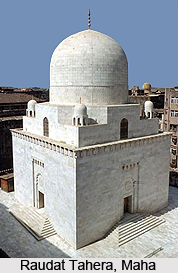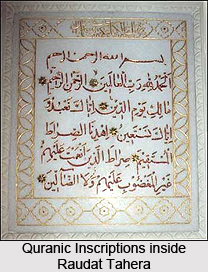 Raudat Tahera is a famous mausoleum of the renowned Dr. Syedna Taher Saifuddin and also his son Syedna Mohammed Burhanuddin, who rendered their services as the 51st and 52nd Dai al-Mutlaq of the community of the Dawoodi Bohra. It is located in the region of Bhendi Bazaar, central Mumbai, Maharashtra. Syedna Saifuddin had educated this community from 27th January, 1915 till his demise on 12th November, 1965. The 52nd Dai al-Mutlaq Dr. Syedna Mohammed Burhanuddin was his son who died on 17th January, 2014. He was finally buried in this very mausoleum by Syedna Mufaddal Saifuddin, who was his son and the 53rd Dai al-Mutlaq of Dawoodi Bohra community. Yahya Merchant was the chief architect of this mausoleum who was the creator of this tomb. Different foreign dignitaries and heads of state paid visit to Raudat Tahera to offer their prayers and respects. Raudat Tahera is one of its kind and boasts of unique architectural style.
Raudat Tahera is a famous mausoleum of the renowned Dr. Syedna Taher Saifuddin and also his son Syedna Mohammed Burhanuddin, who rendered their services as the 51st and 52nd Dai al-Mutlaq of the community of the Dawoodi Bohra. It is located in the region of Bhendi Bazaar, central Mumbai, Maharashtra. Syedna Saifuddin had educated this community from 27th January, 1915 till his demise on 12th November, 1965. The 52nd Dai al-Mutlaq Dr. Syedna Mohammed Burhanuddin was his son who died on 17th January, 2014. He was finally buried in this very mausoleum by Syedna Mufaddal Saifuddin, who was his son and the 53rd Dai al-Mutlaq of Dawoodi Bohra community. Yahya Merchant was the chief architect of this mausoleum who was the creator of this tomb. Different foreign dignitaries and heads of state paid visit to Raudat Tahera to offer their prayers and respects. Raudat Tahera is one of its kind and boasts of unique architectural style.
History of Raudat Tahera
The construction of Raudat Tahera commenced during 10th December, 1968 and it was during the 21st of Ramadan Hijri 1388 of the Fatimid Calendar which was the death anniversary of Moula Ali. Raudat Tahera was officially inaugurated on 19th April, 1975 by Fakruddin Ali Ahmed, the Indian President which coincides with the birthday of Imam Taiyab abi-al-Qasim according to the Hijri calendar of the 4th Rabi-ul- Akhir, 1395.
 Architecture of Raudat Tahera
Architecture of Raudat Tahera
The marble employed to construct the mausoleum had been quarried from Ulodi and Chosira of the noted Makrana quarries which are situated in the state of Rajasthan. It is believed that it was from this very place that the marble for creating Taj Mahal was imported. 92 pillars support the structure and this number is crucial as it portrays the Arabic geometrical value of the name of Prophet Muhammad. The complete Raudat Tahera weighs nearly 5000 tons. Its height is 108 feet and the height of its dome is 52 feet. Aaliqadr Moula Syedna Mufaddal Saifuddin had laid the first brick for the erection of the dome. Four tiny domes are a part of this mausoleum, each of which is adorned with a gold layer and each of them are placed at each corner of the central dome. A thick masonry wall measuring 4 feet in height is also present. The outer walls of Raudat Tahera are embellished with the names of Duat Mutlaqeen in Kufic script and Aimmat Tahereen.
The four entrance gates of the shrine are designed in such a manner that it closely resembles the entrance gate of Al Jamea Al Aqmar in Cairo. The gates are decorated with four silver doors of Fatemi style which lead one to the sanctum sanctorum of the tomb.
Inner height of the mausoleum measures 80 feet in height and the central portion of the tomb contain the burial place of the Syedna Taher Saifuddin which measures 28 square feet in area. Over the four walls are inscribed the entire Quran of 772 pages on the instructions of Syedna Mohammed Burhanuddin RA. The Quran inscriptions stretch to the southern wall from the right part of the western wall and finally end on the left side of the northern wall. A beautiful crystal chandelier hangs suspended from the central area of the dome and illuminates all the four precincts of the mausoleum.



















